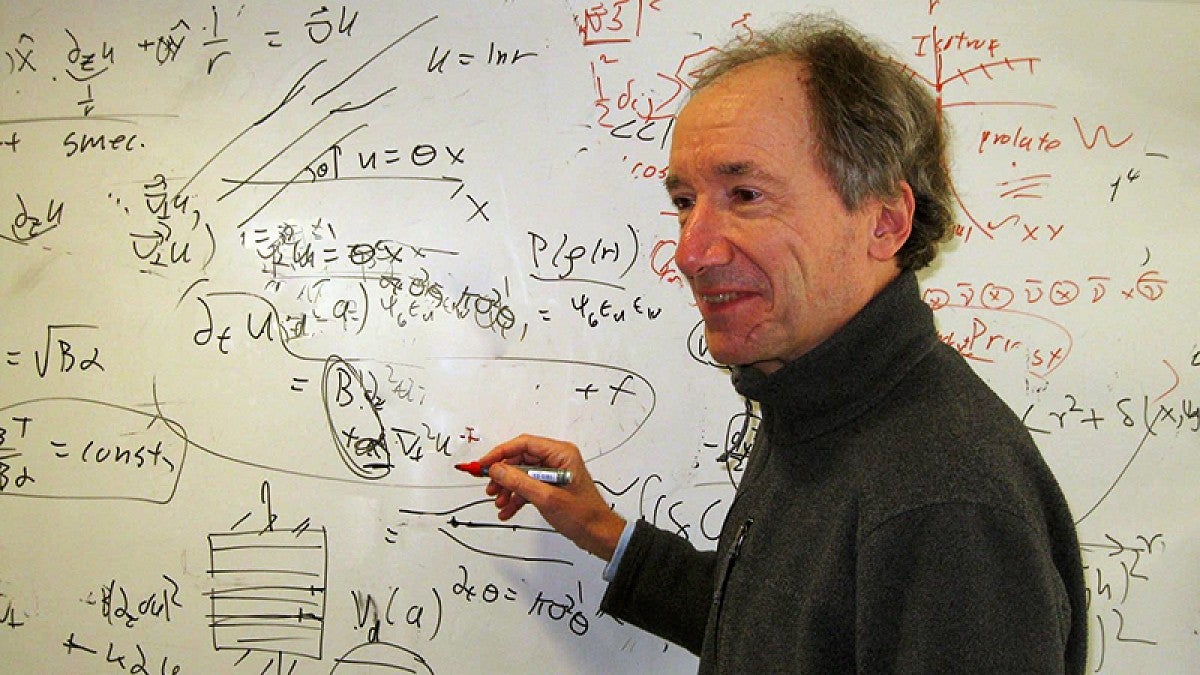John Toner was frustrated during his final year with IBM in 1993. The industry giant, amid the internet-fueled technological explosion, was giving up fundamental research, his specialty, to pursue applied science to stay competitive.
But a lecture by a visiting researcher, which he almost didn’t attend, reignited this passion and called on his knowledge of fluid mechanics. In his final project at IBM, which he started while considering a job offer from the University of Oregon, he teamed with a young new colleague, Yuhai Tu, to dig deeper into the speaker’s topic.
Within a day, Toner and Tu wrote a short equation that explained how the motion of individual birds in a flock affects the motion of neighboring birds:

That formula has landed Toner, Tu and that day’s speaker, Hungarian scientist Tamás Vicsek, the Lars Onsager Prize from the American Physical Society “for seminal work on the theory of flocking that marked the birth and contributed greatly to the development of the field of active matter.”
The Lars Onsager Prize, among 39 prizes announced by the society this fall, has local significance. It was established in 1993 by UO physicist Russ Donnelly, who died in 2015, and his wife Marian in memory of their friend Lars Onsager, a physical chemist and theoretical physicist who won the Nobel Prize in Chemistry in 1968. Two previous winners of the Onsager prize later won Nobel Prizes.
“I had heard from a colleague that when Russ founded this award it was his hope that somebody from the UO would win it,” said Toner, a professor of physics, as he sat in front of a chalkboard filled with equations. “I’m honored to win this award, which is for theoretical statistical physics.”
Statistical physics, he said, deals with physical systems substantially affected by randomness.
“Theorists are people who come up with ideas that can then be tested by others in experiments,” Toner said.
Vicsek was seeking to understand flocking when he spoke at IBM. He had completed a “bare-bones computer simulation, a simple model of flocking,” which, Toner said, proposed that such group behavior could happen in two-dimensional space.
“Before his work, everyone thought that getting all movement in one direction would be as hard as getting everyone in a room to point in the same direction,” Toner said.
Under the Mermin-Wagner theorem, such a coordinated action in a 2D space was not possible. As an example, Toner said, put a million Willamette Valley residents in an empty vast field shrouded in fog, without the sun or a compass to guide them, and tell them to point in the same direction. They couldn’t, he said, because their visibility of where others are pointing is limited. Vicsek’s simulation, however, showed that if the instruction is to walk rather than point, everyone could go in the same direction.
“The key is movement. You get order with movement,” Toner said. “Our equation describes any kind of flock.”
The Toner-Tu equation, as it is now known, has ignited research on active matter, providing a base formula for understanding a potentially wide range of applications.
“Yuhai and I were the first two people to apply the ideas of fluid mechanics to living systems and active self-propelling systems,” Toner said. “This field is based on our equation. It includes flocking but applies to any situation in which you have components that can move in some way, provided they all move together.”
Since joining the UO in 1995, Toner has sought to understand the implications of the Toner-Tu equation. He likens its potential to the Navier-Stokes equation, put forth in 1822, that describes the motion of viscous fluid substances.
The Navier-Stokes equation has been the foundation of thousands of research articles in many research journals over the past two centuries. The journal Fluid Mechanics, which began publishing in 1854, is devoted almost entirely to studying the Navier-Stokes equation. It has guided the design of aircraft, cars and power stations; the study of blood flow; and analyses of pollution.
Soon after learning he’d won the award, Toner left for a six-month fellowship at the Max Planck Institute for the Physics of Complex Systems in Dresden, Germany, as the 2019-20 Martin Gutzwiller fellow.
He’ll be working, he said, in a division of the Max Planck Institute that is perfect for his research on flocking, which helps to explain systems as diverse as animals, birds, bacteria, molecular motors in cells, cancer cells, fish and even tiny plastic rods on a vibrating table moving in the same direction.
Toner, a fellow of the American Physical Society, holds a bachelor’s degree from the Massachusetts Institute of Technology and master’s and doctoral degrees in physics from Harvard University.
—By Jim Barlow, University Communications


